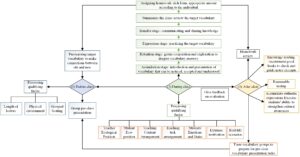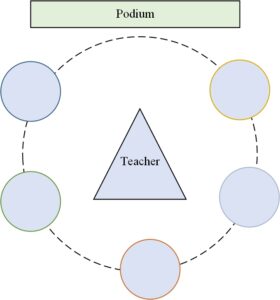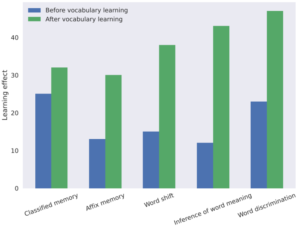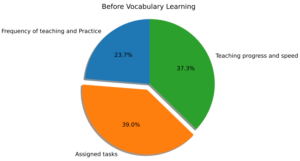The new curriculum standards have put forward new requirements for high school English vocabulary teaching, and the English vocabulary eco-classroom under the guidance of ecological linguistics theory can precisely make up for the shortcomings in the traditional vocabulary classroom and meet the challenges of the times. However, most of the existing researches on ecological classroom are combined with macro English subjects, and few of them are about English vocabulary teaching. This study takes the principles of ecological linguistics as the theoretical basis to support the conceptual construction and morphological reliance of the vocabulary ecological classroom, supplemented by modal theory as the process orientation of the four major stages in the teaching process, constructs a new vocabulary ecological classroom model based on Markov chain model, and applies the ecological classroom model to high school English vocabulary teaching to verify its teaching effects. The experimental results show that the Markov chain-based high school English vocabulary teaching under the “ecological linguistics” model can help students’ interest in vocabulary learning and promote their vocabulary learning level, accounting for 15% improvement in the learning effect.
Vocabulary is not only the cornerstone of language, but also the carrier of culture. Vocabulary itself is imprinted with the history of the language and permeated with the worldview of the nation. Wilkins, a British linguist, pointed out that we can express very little without grammar, but we cannot express without vocabulary [1,2]. The basic skills are inseparable from vocabulary, so mastering vocabulary is a necessary prerequisite for language mastery. For professors, it is not only about teaching the meaning of the vocabulary itself, but also about conveying the culture behind the vocabulary. For the learner, it is not only the information conveyed by the vocabulary but also the ability to learn the vocabulary [3]. This is a sublimation of the five-dimensional goals proposed in the previous curriculum standards. The proposed core literacy of English subject also puts forward new requirements for English teaching and indicates a new direction. Unlike other subjects, English teaching should emphasize the cultivation of cross-cultural awareness and international perspective [4,5].
The core literacy of English subject has also put forward new requirements for English vocabulary teaching. The teaching of English vocabulary under the guidance of the new curriculum standards should pay attention to the teaching of the cultural background knowledge conveyed by vocabulary; to the practical application of vocabulary by students; to the way of teaching vocabulary and to helping students to develop good vocabulary learning habits [6,7]. However, the traditional English vocabulary classroom only focuses on teaching the meaning of English vocabulary, and mostly adopts the mechanical and boring mode of reading aloud and writing silently.
In this paper, by reading a lot of literature about the current situation, we find some shortcomings in the existing English vocabulary teaching. First of all, teachers mostly adopt the method of indoctrination for mechanical teaching. Due to the constraints of teaching tasks and time, teachers mostly adopt a single form of teaching, such as leading reading, mimeographing, explaining the meaning of words, and explaining usage collocation. On the whole, the classroom is teacher-centered, with teachers teaching more than students practicing, and teachers rarely pay attention to feedback from students[8]. It is easy to see that under such a teaching method, students’ participation and enthusiasm are low, and it is difficult to stimulate students’ learning enthusiasm and improve their vocabulary learning efficiency.
Second, teachers’ teaching of vocabulary is mostly fragmented and unsystematic. This leads to students’ inability to make connections between vocabularies, resulting in a heavy memory burden, low vocabulary learning efficiency, and rapid forgetting. This way of teaching ignores the intrinsic properties of vocabulary and students’ cognitive level and thinking ability, and does not help students to build up a vocabulary system and network well, and breaks up the connections between vocabulary[9].
Teachers neglect the instruction of vocabulary memorization methods. According to the knowledge of English lexicography, English vocabulary can be taught in terms of etymology, root words and affixes, thus improving students’ learning efficiency and interest. The lack of memorization methods and learning strategies makes students’ learning of English vocabulary seem incompetent. At the same time, teachers focus only on students’ grasp of vocabulary meanings and neglect students’ mastery of vocabulary pronunciation. The mastery of phonetics is also one of the important tools to help students master vocabulary[10,11].
Finally, in the classroom, teachers usually focus on those students who are top achievers and expressive, while neglecting those who are weak learners and introverted, resulting in a tendency for teachers to teach at a pace that causes the distance between students to be widened and polarization to be serious. At the same time, in vocabulary teaching, teachers usually ignore the cooperative communication learning among students and replace it with teachers’ lectures, which makes students’ main consciousness and class participation greatly reduced[12].
To sum up, there are still many shortcomings in traditional vocabulary teaching to be solved. Facing these shortcomings of traditional vocabulary teaching, the emergence of vocabulary eco-classroom will break this deadlock. It is a kind of dynamic student-centered ecological classroom, which can not only cultivate students’ interest in vocabulary learning, but also improve their vocabulary learning level.
The teaching elements can only achieve harmony with the environment if they reach an optimal spatial and temporal position in the “ecosystem” of competition and symbiosis. The environment identified by the language teaching ecosystem is a dynamic, integrated and balanced environment, which should have the functions of regulating the interrelationship among the elements within the system and regulating the teaching activities, making the teaching elements interdependent, interacting and transforming with each other, etc.”[13,14]. For the ecological English vocabulary teaching classroom, we should actively consider that students, teachers and the ecological environment are in a digital era of rapid development, make full use of digital technology, multimedia and other media, adopt multimodal teaching methods, adopt different teaching strategies to mobilize the enthusiasm of learning subjects inside and outside the classroom according to the different sections of each unit of English vocabulary teaching, and fully dialogue and interact with each element of the ecological environment In this paper, the overall process of the vocabulary eco-classroom will be presented in the form of a flow chart as shown in Figure 1, supplemented by a table to illustrate the teaching-related constructs as shown in Table 1.

| Limiting Factor | Schedule |
| Class Length | The vocabulary ecology class was conducted twice a week, with each session lasting 45 minutes. |
| Physical environment | Classes were held in a bright and spacious classroom with multimedia. |
|
Seating arrangement
classroom grouping |
Seating was arranged in round tables (see Figure 2). Students were grouped and seated according to their ecological status (differences in personality, classroom
performance). In order to facilitate peer collaboration and reduce the effect of diffusion of responsibility, the author recommends grouping 4 students . |
In general, test results for students should ideally fit the normal distribution; however, based on the data gathered, the students’ results on the three quizzes display a distribution that is negatively skewed, as seen in Figure 1. To confirm whether the original data set satisfies the normal distribution, we will remove the data in this paper that have a significant degree of skewness at both ends and the normal distribution graphs of the data with scores less than 60, as shown in Figure 2. After removing scores of less than 60 a second time, it is clear from comparing Figure 1 and 2 that the students’ quiz results are more concentrated and convergent to the normal distribution. The specific grouping is shown in Figure 2.
Markov chain: If
One-step transfer probability: The conditional probability is
abbreviated as and satisfies
One-step transfer probability matrix: The matrix consisting of one-step transfer probabilities, i.e.,

Flush Markov chain: When the conditional probability is only
related to
In this paper, the most general five-level classification method is
used to classify students’ grades into five levels in descending order:
first level
The teaching process can be viewed as a chi-square Markov chain, and
it is known from its smoothness and ergodicity that there must exist a
unique limiting distribution
The change of students’ performance between grades obviously
corresponds to the progress or regression of performance, when
In the process of teaching, even if students’ performance regresses,
the value of teachers’ work should not be completely eliminated. The
greater the degree of students’ progress, the greater the reward weight
for teachers. By constructing the reward weight matrix
In order to compare the vocabulary level before the experiment with that of the control class, this paper conducted a sampling test on the results of the experiment before the experiment, as shown in Tables 2 and 3.
| Class | N | Mean | SD | SEM | |
| Pre-achievement | Experimental | 50 | 77.19 | 10.288 | 1.454 |
| Control class | 50 | 78.17 | 12.226 | 1.728 |
Table 2 provides descriptive statistics of the results. The average value obtained by the experimental course in the achievement pre-test is 77.19, while the average value obtained by the control course in the achievement pre-test is 78.17. The size of these values indicates that there is little difference between them, but whether they reach the level of statistical difference shown in Table 3.
| Levene’s test | t-test | |||||||||
| Pre-achievement | F | Sig. | t | df | Sig.(Bilateral) | Mean Difference | SE value | 95% confidence | ||
| Lower | Upper | |||||||||
| Assuming equal variances | 1.206 | .274 | -.444 | 97 | .658 | -1.000 | 2.262 | -5.485 | 3.483 | |
| Assume not equal | -.444 | 95.213 | .658 | -1.000 | 2.262 | -5.467 | 3.487 | |||
It can be seen that when the index level is 0.05, the value of experimental control class is 0.658, which is higher than 0.05. Therefore, these two parallel categories can be used as the experimental category and the control category in the experiment [16].
To compare the test results of the laboratory classroom, a pair of sample tests were carried out in Table 4 and 5.
| Class | Mean | N | SD | SEM | |
| For 1 | Pre-achievement | 77.17 | 50 | 10.288 | 1.454 |
| After | 82.81 | 50 | 8.235 | 1.165 |
Table 4 provides descriptive statistics of the results of the experimental course in the background and subsequent measurements. It is worth noting that the average value of previous measurements in laboratory classrooms is 77.18, and the average value of laboratory classrooms is 82.80. As shown in Table 5, whether they are statistically different.
| Mean | SD | SEM | 95% confidence interval | t | df | Sig.( Bilateral) | |||
| For 1 | Lower limit | Upper limit | |||||||
| Pre-achievement- After | -5.622 | 6.384 | .904 | -7.436 | -3.804 | -6.225 | 48 | .000 |
It is noted that at the index level of 0.05, the control test value before and after the laboratory course is 0.000, which is less than 0.05. Therefore, it is considered that there is a significant difference between the measured values before and after the laboratory course, which is significantly higher than the past.
In summary, it can be seen (see Figure 3) that the vocabulary eco-classroom as a whole has a positive effect on students’ vocabulary learning outcomes. However, it is worth noting that 14% of the students reported that they did not participate well in the classroom after the experiment. Another 14% of the students reported that they were inefficient or inattentive.

In this paper, questions were set from vocabulary classification memory ability, word formation memory ability, word change ability, vocabulary discrimination ability, vocabulary speculation ability, and vocabulary usage ability. By comparison, it was found that the mastery of each ability was more optimistic after the experiment (see Figure 4).

In the early and follow-up survey questionnaires, three questions were raised: the frequency of teaching practice, the number of teaching assignments, teaching speed and speed. Through the comparison of pre-test and post test (see Figure 5 and 6), it can be seen that vocabulary ecology is more acceptable to students than vocabulary ecology before the experiment in terms of teaching and learning frequency, workload, learning speed and speed.


Taking the teaching process of English vocabulary in the public foundation course of a university as an example, the university adopts a tiered teaching mode, firstly, the new students are arranged into three types of classes: advanced, intermediate and elementary according to their entrance English scores in descending order, and the classes of each tier are then split into arts and science classes according to the nature of students’ majors. A classroom test is conducted at the beginning of the semester, and then a final test is organized after a semester of teaching process, and the teaching quality of each class is compared and analyzed by analyzing the results of the two tests. In this paper, a random sample of 20 students from each class was taken from an advanced arts class and an advanced science class (hereinafter referred to as the arts and science classes). The transfer of the number of students in each level according to the five-level classification method is as follows (see Tables 6 and 7).
| Semester Final Exam | ||||||
| Beginning of semester exams | 90-100 | 80-89 | 70-79 | 60-69 | 0-59 | |
| 90-100 | 1 | 1 | 1 | 0 | 0 | |
| 80-89 | 2 | 2 | 3 | 1 | 0 | |
| 70-79 | 0 | 1 | 1 | 0 | 0 | |
| 60-69 | 0 | 0 | 1 | 1 | 0 | |
| 0-59 | 0 | 0 | 2 | 0 | 0 | |
| Semester Final Exam | ||||||
| Beginning of semester exams | 90-100 | 80-89 | 70-79 | 60-69 | 0-59 | |
| 90-100 | 0 | 1 | 1 | 0 | 0 | |
| 80-89 | 1 | 1 | 1 | 0 | 0 | |
| 70-79 | 0 | 1 | 5 | 2 | 0 | |
| 60-69 | 0 | 0 | 1 | 0 | 0 | |
| 0-59 | 0 | 2 | 0 | 1 | 0 | |
Vocabulary acquisition includes both vocabulary acquisition interest and vocabulary acquisition habit, acquisition attitude, acquisition effect and acquisition ability. However, most of the existing studies have focused only on vocabulary acquisition effects or vocabulary acquisition habits and have studied them separately. This paper explores the current English vocabulary teaching classroom based on an ecological linguistic perspective, points out the ecological imbalance in the English vocabulary teaching classroom, and proposes measures to solve the problem and strategies to build an ecological English vocabulary teaching classroom, in order to provide some reference for future English vocabulary teaching curriculum reform and curriculum design.
This work supported by The 14th Five-year Plan of Shaanxi Education Science in 2021: The Application of Project-based Learning in Cultivating Students’ Professional Ability of Pre-service English Teachers(No. SGH21Y0443).
The authors declare no conflict of interests.
Shi, W. and Li, W., 2021. The exploration of academic English vocabulary teaching model based on POA. Sch Int J Linguist Lit, 4(1), pp.9-13.
Cox, C.R. and Haebig, E., 2023. Child-oriented word associations improve models of early word learning. Behavior Research Methods, 55(1), pp.16-37.
Li, Y., 2022. Construction of Internet of Things English terms model and analysis of language features via deep learning. The Journal of Supercomputing, 78(5), pp.6296-6317.
Chan, W.W.L. and Kwan, J.L.Y., 2021. Pathways to word problem solving: The mediating roles of schema construction and mathematical vocabulary. Contemporary Educational Psychology, 65, p.101963.
Su, L., Xiao, L. and Wang, J., 2021. A case study of the ideological and political education of college English translation course driven by words. Creative Education, 12(02), p.317.
Ramos-HolguĆn, B., 2021. Comprehending Interculturality and its Future Directions in English Language Teaching and Teacher Education in the Colombian Context. HOW, 28(3), pp.93-104.
Lo, J.H., Lai, Y.F. and Hsu, T.L., 2021. The study of AR-based learning for natural science inquiry activities in Taiwan’s elementary school from the perspective of sustainable development. Sustainability, 13(11), p.6283.
Nai, R., 2022. The design of smart classroom for modern college English teaching under Internet of Things. Plos one, 17(2), p.e0264176.
Alsubari, S.N., Deshmukh, S.N., Alqarni, A.A., Alsharif, N., Aldhyani, T.H., Alsaade, F.W. and Khalaf, O.I., 2022. Data analytics for the identification of fake reviews using supervised learning. Computers, Materials & Continua, 70(2), pp.3189-3204.
Huei, L.S., Yunus, M.M. and Hashim, H., 2021. Strategy to Improve English Vocabulary Achievement during COVID-19 Epidemic. Does Quizizz Help?. Journal of Education and e-Learning Research, 8(2), pp.135-142.
Peng, R. and Fu, R., 2021. The effect of Chinese EFL students’ learning motivation on learning outcomes within a blended learning environment. Australasian Journal of Educational Technology, 37(6), pp.61-74.
John, P.W., Mohamad, M., Mahmud, S.N.D. and Fuad, N.I.M., 2021. The perceptions of tertiary level learners on the use of mobile app ‘Balloon Vocabulary’in improving vocabulary for reading comprehension. Theory and Practice in Language Studies, 11(9), pp.1007-1017.
Baxter, P., Bekkering, H., Dijkstra, T., Droop, M., van den Hurk, M. and Léoné, F., 2021. Grounding second language vocabulary instruction in cognitive science. Mind, Brain, and Education, 15(1), pp.24-34.
Zhou, J., Li, B., Zhang, D., Yuan, J., Zhang, W., Cai, Z. and Shi, J., 2023. UGIF-Net: An efficient fully guided information flow network for underwater image enhancement. IEEE Transactions on Geoscience and Remote Sensing, 61, pp. 1-17.
Ali, J., Shan, G., Gul, N. and Roh, B.H., 2023. An intelligent blockchain-based secure link failure recovery framework for software-defined internet-of-things. Journal of Grid Computing, 21(4), p.57.
Ren, X., Ahmed, I. and Liu, R., 2023. Study of topological behavior of some computer related graphs. Journal of Combinatorial Mathematics and Combinatorial Computing, 117, pp.3-14.
1970-2025 CP (Manitoba, Canada) unless otherwise stated.